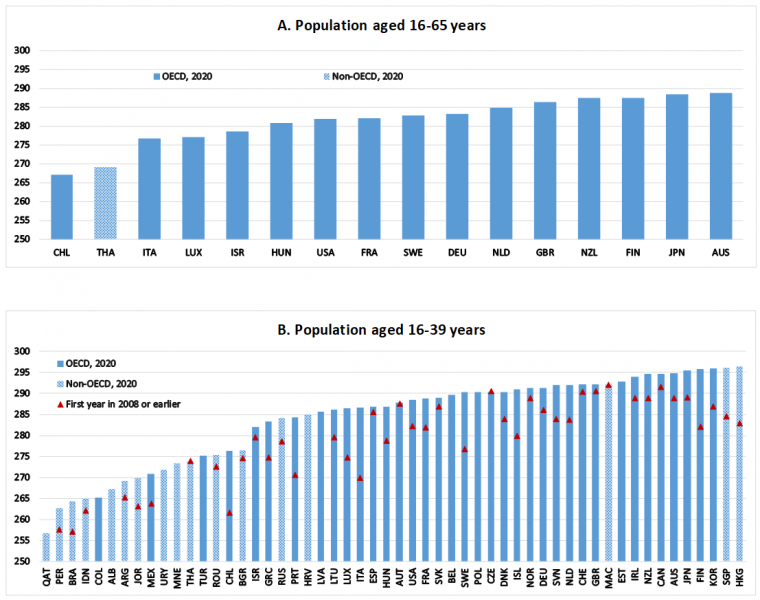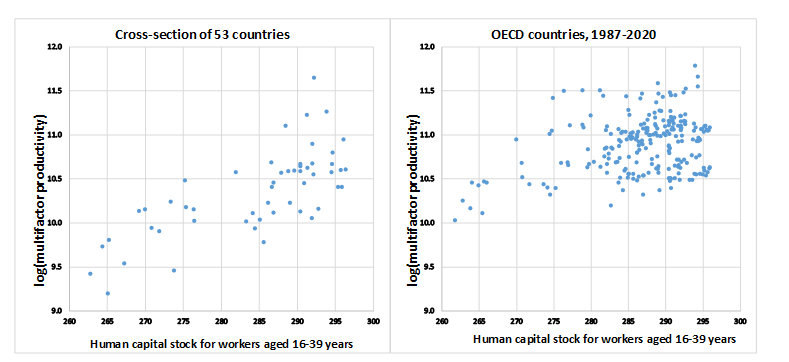

We construct a new aggregate stock measure of human capital using cohort-level PIAAC [Programme for the International Assessment of Adult Competencies] surveys, PISA test scores (the quality of education), and mean years of schooling (the quantity of education). The relative weights of quality and quantity are estimated rather than imposed like in the existing literature. Improvements in human capital are estimated to boost TFP significantly, but only with long lags. We simulate the impact of pre-primary education on human capital and productivity to demonstrate the usefulness of the new measure for policy analysis.
The empirical literature aimed at constructing a measure of human capital at the country level has combined quantity (such as mean years of schooling) and quality (typically internationally standardised test scores) components either using arbitrary, most often equal, weights (Filmer et al., 2018; Reiter et al., 2020, Angrist et al., 2021) or by including them separately in estimations, usually with the implausible outcome that one component is dominant and the other completely insignificant (Coulombe et al., 2004; Hanushek and Kimko, 2000; Hanushek and Woessmann, 2007, 2012; Fournier and Johansson, 2016; Botev et al., 2021). A further weakness of many studies that try to incorporate notions of quality into measures of the human capital stock is that they are based on contemporaneous flow measures that most often relate to students tested at age 15, which are unlikely to be representative of the skills of the entire (and older) working age population. Improving aggregate measures of human capital is important given the central role that education, training and skills play as a driver of economic performance.
To address the shortcomings of previous empirical studies, in a recent OECD work (Égert et al, 2022), we construct a new stock measure of human capital that accounts for the quality and quantity of education and makes use of OECD data from the Programme for International Student Assessment (PISA), the Programme for the International Assessment of Adult Competencies (PIAAC) and mean years of schooling.
The new measure is a cohort-weighted average of past PISA scores (representing the quality of education) of the working age population and the corresponding mean years of schooling (representing the quantity of education). Contrary to the existing literature, the relative weights of the quality and quantity components are not imposed or calibrated but are estimated directly.
This approach combines data from both PISA and PIAAC in order to overcome inherent problems with using either in isolation. On the one hand, PIAAC provides a measure of skills for the entire adult working age population, but has no time series and limited country coverage, hence ill-suited for empirical regression analysis. On the other hand, PISA only applies to those aged 15 but, very importantly, especially when combined with similar international test scores, has a more extensive time series and country coverage.
Our calculations involve three stages.
The new measure of human capital for the population aged 16 to 65 years suggests that the countries with the greatest human capital include Australia, Japan and Finland, while Chile and Thailand have the lowest levels of human capital (Figure 1, Panel A).1 These rankings for the last available year are broadly confirmed for the stock covering the population aged 16-39 (Figure 1, Panel B), although there are some differences suggesting that younger generations have been increasingly better educated in some countries than in others. For instance, Finland lags behind Japan for the total stock, but the countries flip places for the stock covering only the younger generations, because the stock of human capital of younger generations has risen more strongly in Finland compared to Japan.
Figure 1. The new measure of the stock of human capital

Note: The stock of human capital is calculated as the cohort-weighted average of student test scores and mean years of schooling, both adjusted for the coefficient estimates linking them to PIAAC adult test scores to PISA student test scores (log-log specification with country fixed effects, transformed from log to levels). The first years in panel B range from 1987 to 2008.
The new measure of human capital shows a robust positive correlation with productivity for 53 OECD and non-OECD countries in 2020 and, albeit to a less extent, for OECD countries in cross-country time-series panel regressions, suggesting that improvements in human capital are accompanied by macroeconomic productivity gains (Figure 2).
Simulations suggest that the potential for long-run productivity gains is much greater from improvements in the quality than the quantity component of human capital. An improvement in PISA test scores, equivalent to closing the gap between the median and the top three performing OECD countries, eventually generates a long-run increase in multi-factor productivity (MFP) of between 3.4% and 4.1%. Alternatively, a similar increase in mean years of schooling, also corresponding to reducing the gap between the median and the top three performing OECD countries, generates an increase in TFP of between 1.8% and 2.2%.
Another finding is that gains in productivity through the human capital channel can be of the same order of magnitude as from improving product market regulation, again using the same benchmark of closing the gap between the median and the top three performing OECD countries. The lags are, however, also typically much longer from the human capital channel, particularly because it takes almost five decades before a sustained improvement in student skills are fully reflected in improvements in the skills of the entire working age population. These long lags can be shortened by putting more emphasis on adult learning including life-long learning and upskilling of the existing workforce, improving human capital at older ages.
Figure 2. The new measure of human capital has a strong relationship with productivity

Note: The years displayed in panel B are 1987, 1992, 1997, 2002, 2005, 2008, 2011, 2014, 2017 and 2020.
An attractive feature of the new stock measure of human capital is that it opens up new avenues for evaluating the effect of education policy reforms on productivity and per capita income. Any education policy, which can be measured quantitatively through an indicator and linked to changes in student test scores, can be related to the new measure of human capital and so to productivity.
We use pre-primary education as an illustrative example. The first step in the quantification of the effect of pre-primary education attendance is provided by the existing empirical literature using microeconomic student-level data, which finds that students previously enrolled in pre-school for more than one year perform better in student skill tests, improving their test scores by between 8.2 and 9.6 points (Schütz, G., 2009; Fuchs, T. and L. Woessmann, 2007; Hanushek E. and L. Woessmann, 2006; André et al., 2019). This corresponds to an increase of 1.7% to 1.9% compared to the OECD median PISA score in 2018.
In order to assess the policy effects on the stock of human capital and multi-factor productivity from reforming pre-primary education, two scenarios are considered: i.) closing the gap between the lowest level of pre-primary attendance observed in the OECD (9% in Turkey) and the average of the top three performers (84%, Spain, France and New Zealand), and ii.) closing the gap between the median OECD country (72%, Austria) and the average of the top three performers. Results indicate that a sustained effort to increase attendance in pre-primary education boosts productivity in the long run between 0.9% and 2.2% for the first scenario, and gives rise to a more limited increase of 0.1% to 0.3% in the second scenario.
Future work will focus on a systematic evaluation of a wide range of education policies on the new measure of human capital and macroeconomic outcomes as well as considering how adult training policies impact on human capital.
André C, J. Pareliussen and H. Hwang (2019), “What Drives the Performance of Swedish Lower Secondary Schools?”, OECD Economics Department Working Papers, No. 1586.
Angrist, N, S Djankov, P K Goldberg and H A Patrinos (2021), “Measuring human capital: Learning matters more than schooling”, VoxEU.org, 09 April.
Botev, J., B. Égert, Z. Smidova and D. Turner (2021), “Human capital in OECD countries: A new measure and its policy drivers”, VoxEU.org, 06 January.
Coulombe, S., J. Tremblay and S. Marchand (2004), “International Adult Literacy Survey: Literacy Scores, Human Capital and Growth across Fourteen OECD Countries”, Statistics Canada, Catalogue No.89-552-MIE.
Égert, B., C. de la Maisonneuve and D. Turner (2022), “A New Macroeconomic Measure of Human Capital Exploiting PISA and PIAAC: Linking Education Policies to Productivity”, OECD Economics Department Working Papers, No. 1709.
Filmer, D., H. Rogers, N. Angrist and S. Sabarwal (2018), “Learning –adjusted years of schooling (LAYS): Defining a new macro measure of education”, World Bank Policy Research Paper, No. 8591.
Fournier, J-M and A. Johansson (2016), “The effect of the size and the ix of public spending on growth and inequality”, OECD Economics Department Working Paper, No. 1344.
Fuchs, T. and L. Woessmann (2007), “What Accounts for International Differences in Student Performance? A Re-examination Using PISA Data”, Empirical Economics, 32 (2007), 433-464.
Hanushek, E.A., Kimko, D.D. (2000). “Schooling, Labor-Force Quality, and the Growth of Nations”. American Economic Review, 90(5), pp. 1184-1208.
Hanushek, E.A. and L. Woessmann (2006), “Does Educational Tracking Affect Performance And Inequality? Differences-in-Differences Evidence Across Countries”, The Economic Journal, 116 (March), C63–C76. Hanushek, E.A., Woessmann, L. (2007). “The Role of Education Quality in Economic Growth”. World Bank Policy Research Working Paper, 4122. Washington, D.C.
Hanushek, E. A. and L. Woessmann (2011), “The Economics of International Differences in Educational Achievement”, Handbook of the Economics of Education, Vol. 3 (2011), 89-200.
Hanushek, E. and L. Woessmann (2012), “Schooling, Educational Achievement, and the Latin American Growth Puzzle”, Journal of Development Economics, 99(2), 497-512.
Reiter C, Özdemir C, Yildiz D, Goujon A, Guimaraes R and W. Lutz (2020), “The Demography of Skills-Adjusted Human Capital”, IIASA Working Paper, No. 20-006.
Schütz, G. (2009), “Does Quality of Pre-primary Education Pay off in Secondary School? An International Comparison Using PISA 2003”, Ifo Working Paper no. 68, Ifo Institute for Economic Research, University of Munich, Germany.
|
About the authors Balázs Égert is a Senior Economist at the OECD. He previously worked at the Austrian Central Bank (2003-2007). He was Visiting Researcher at the South African Reserve Bank (2007), Bruegel (2006), CESifo (2006), the Czech National Bank (2006), the central bank of Hungary (2005), the Bank of Finland/BOFIT (2004/2005) and the Bank of Estonia (2002). He earned his PhD at the University of Paris X-Nanterre (2002). Christine de La Maisonneuve is an Economist in the OECD Economics Department currently working on the quantitative assessment of structural reforms in the Macroeconomic Analysis Division. She has worked extensively on human capital, health and long-term care, ageing issues and long-term growth scenarios. She also contributed to many economic surveys of OECD members and emerging economies. David Turner has held a variety of posts at the OECD since joining in 1991, but has been Head of the Macroeconomic Analysis Division since 2009. His main responsibilities currently include overseeing the analysis of potential output, modelling the effects of structural reforms and long-term projections for the global economy. |
There are a limited number of countries (16) with a sufficiently long time series of student test scores to be able to construct the measure for the full working age population. This implies a trade-off. A comprehensive measure covering the entire working age population can only be computed for 15 OECD countries. A measure covering those aged 16 to 39 is available for a total of 54 OECD and non-OECD countries in the last available year, and 12 countries have data series for more than 20 years and an additional 27 countries are covered for about a decade.